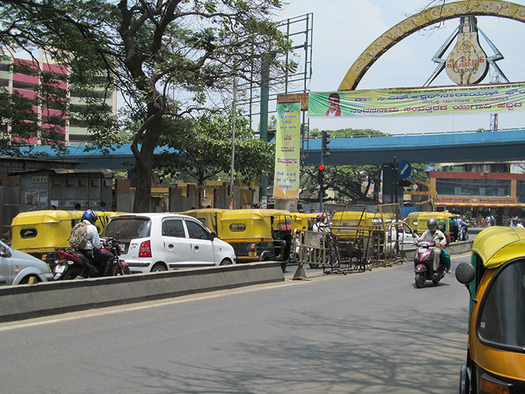
Traffic in Bangalore (Figure 1)
February 8, 2012
MG Road
Bangalore, Karnataka, India
I’m perched tentatively on the sidewalk, waiting for an opening to cross. In the street before me a steady stream of cars, trucks, buses, motorcycles and auto-rickshaws whizzes past, everybody honking, veering and jockeying for position (Fig. 1). Out in the traffic flow seemingly suicidal pedestrians are darting between vehicles in a relaxed bid to reach the other side. Did I say “relaxed”? The traffic does not give way to them, but they don’t seem intimidated. Although pedestrians obviously do not have the right of way, traffic moves slowly, and few ever get hit. Like a superstitious swimmer, I touch my foot down to the street as if to test the water, then instantly draw back. “This is crazy,” I say to my son Chris who, leaping down with a short hop shouts over the his shoulder, “You’ve got to be decisive. Go with the flow,” then disappears into the throng.
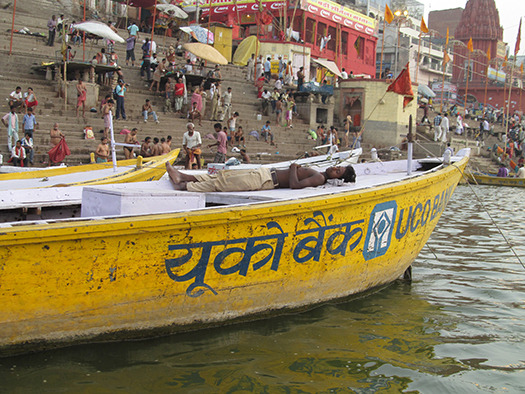
Man sleeping on a boat on the Ganges (Figure 2)
I’ve come to India in search of a comparison and an ideal. The comparison was to Africa, where I’ve done extensive prior documentation of vernacular design. I had a notion that India might yield similarly spectacular results. That was a mistake. India is really like no other place on earth, and beggars comparison. It is as different from Britain’s former African colonies as America is from England itself. The ideal was conceived over 30 years ago when I first encountered the films of the great Bengali film maker Satyajit Ray, specifically, Pather Panchali, his masterpiece made over a three-year period in the 1950’s for a total of $3000. These days there is a Satyajit Ray Film and Television Institute in Calcutta, and a Satyajit Ray Film and Study Center at University of California Santa Cruz. But my film-induced ideal of rural India — where everyone now has a cell phone — proved to be romanticized, and badly in need of revision (Fig. 2). Situated in Bangalore, India’s IT miracle city located in the south central state of Karnataka, underwritten by a research grant from the USIEF Fulbright-Nehru program, I quickly learned two things: 1) how to cross busy streets, and that 2) India defeats all preconceived notions.
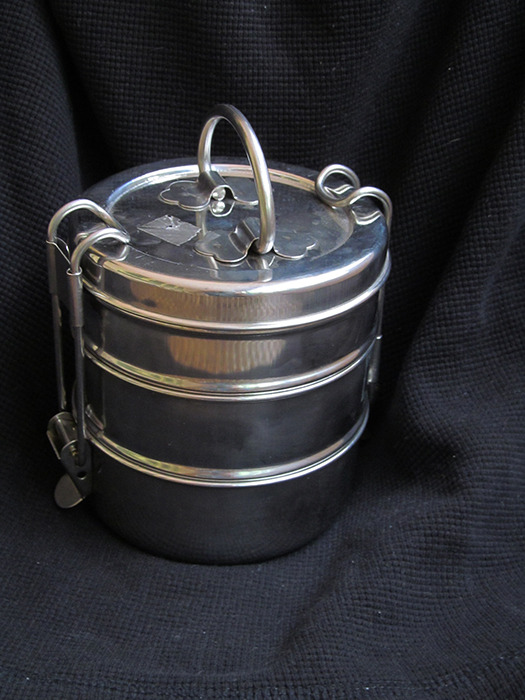
Three dish tiffin (Figure 3)
Take the concept of jugaad, India’s recent design export. The word means “self-sufficient,” and refers to homemade vehicles cobbled together from spare parts in rural areas. But a broader interpretation, in the form of an exhibition exported to the US in 2011, Jugaad Urbanism, extends the term to include everything from tiffin lunch pails (Fig. 3), which are a homegrown Indian invention, to three-wheeled auto-rickshaws (Fig. 4), which in many places vie to become India’s main form of public transit, but are a design imported from Italy. Even Tata Nanos have been considered jugaad influenced. All of these products are industrially mass-produced, and the Nano especially is great for urban commuting, where the ground is smoothly paved. It wouldn’t be much good over uneven ground in the villages where jugaad began. The design world’s fascination with India’s version of DIY will eventually pass, but some themes in Indian design promise to be around for many years more.
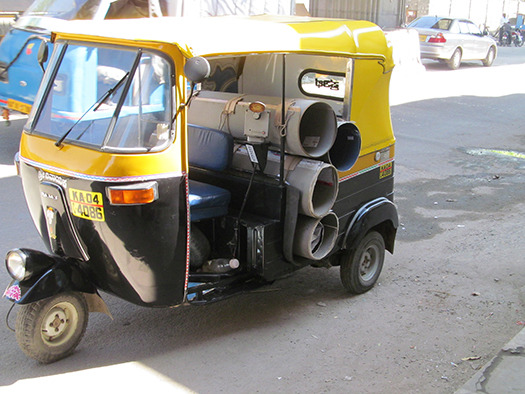
Bajaj auto-rickshaw (Figure 4)
An example of Indian design longevity would have to be the lota. (Fig. 6) Charles Eames famously described it as a truly original Indian design form. Made from a variety of materials: plastic, bronze, stainless, brass, clay and — my favorite — hammered copper, it is a vessel used to carry water and store drier materials. Shaped so it can be held between the hip and the inner arm, lotas save Indian women from having to transport water on their heads, like African women do. They also are made in a wide range of sizes, from tiny to gigantic, and defined Indian hygiene before the advent of indoor plumbing. An instance of a more recent and, I think, more sustainable indigenous design motif is the leaf plate (Fig. 5), available in markets across southern India. Made from areca nut palm leaves that are washed, layered, and hot pressed into a variety of shapes, these objects, which can sometimes be found littering the ground outside temple precincts after holidays, replace heavily processed paper and plastic plates with something completely biodegradable. But, if one needs to have his notions about simple objects reconsidered, what about the broader social implications of India’s recent growth? It’s going to take a few months to wrap my mind around this vastly larger topic.
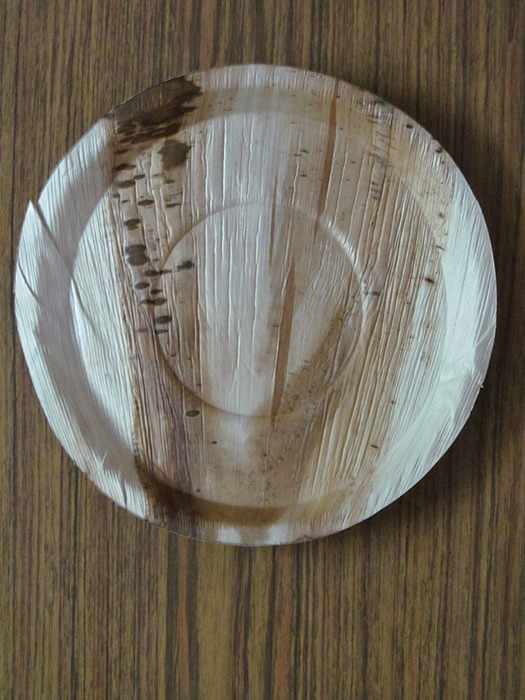
Areca nut leaf plate (Figure 5)

Large bronze lotas (Figure 6)
March 12
Mallesvaram
Bangalore
Living in India one learns that everything has its place. Modern shopping malls exist here, and are popular with the middle class, but those who are more serious about shopping for food than brand association frequent local markets and open-air bazaars. These range from the large centralized places, where cows are milked right on the street and you can find any sort of material imaginable from flowers to hardware, to evening street markets where merchants keep shops open ’til dark and hundreds of vendors spread their cloth on the ground or set up their cart on the narrow alleys and sidewalks between 4 and 9pm. Some American cities have Saturday, or farmer’s markets, but continuous outdoor, small vendor retail is really a thing of the past there. What American cities don’t have is anything like the craftsmen who set up on the sidewalks of India. I’ve seen everything from key cutters to carpenters with their toolboxes waiting to be hired. My all-time favorite has to be the blinds-maker (Figs. 7-8) who set up production right on a street corner. While his assistants split bamboo poles into narrow strips, he wove the strips into blinds.
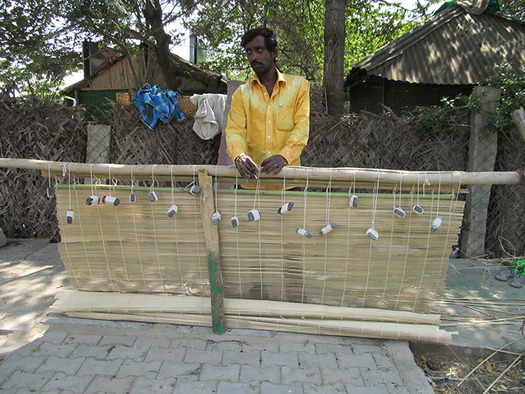
Blinds-maker (Figure 7)
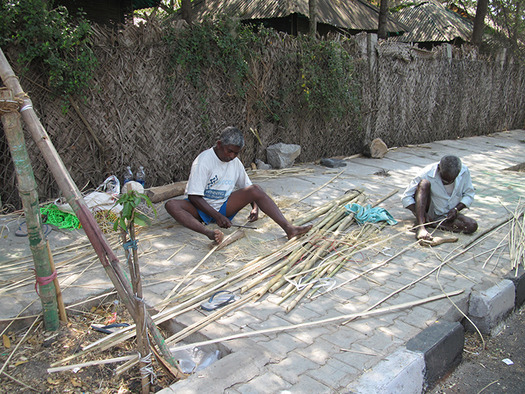
His assistants (Figure 8)
Bangalore began as a military cantonment. After the last King of Mysore, Tipu Sultan, was killed by the British near Bangalore in 1799, the town passed to the colonial power. The caste system originally created hierarchies of professions, and craft-based villages grew up on the outskirts of cities. There would be, say, a village of blacksmiths, or a village of leather tanners, the last "untouchable" because it meant working with dead animals. Bangalore has both a Bamboo Road and a Pottery Town, now firmly ensconced within the city’s limits. When looking for ladders or poles, one goes to Bamboo Road (Fig. 9). If in the market for clay lamps or water jugs, get yourself to Pottery Town (Fig. 10). Of course, each place offers more material examples, although to find bamboo furniture I had to visit a special manufacturer in Pondicherry.
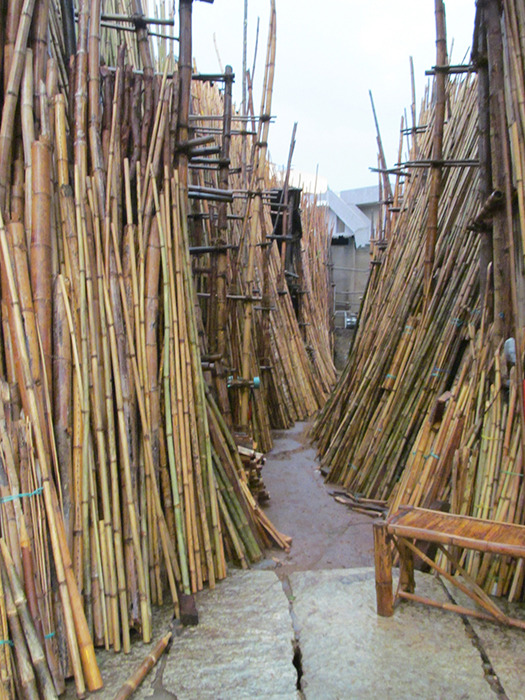
Bamboo dealer (Figure 9)
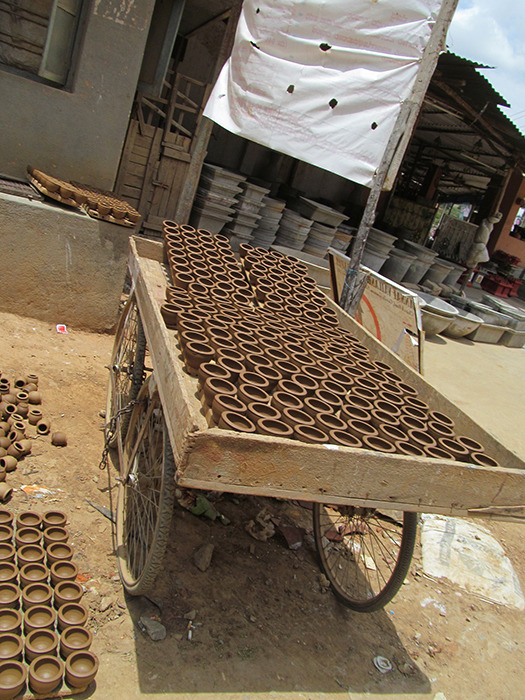
Clay cups sun drying in Pottery Town (Figure 10)
March 29
Munnar
Kerala
Our first venture outside Bangalore is to the hill station town of Munnar, a center of tea production in India’s Western Ghats. Surrounded by the seven plantations of the employee-owned Kanan Devan Hills Company, the tea museum’s sample production facility demonstrates how tea is harvested and processed. The British first began planting this cash crop here in the 1870s, and the cool 5-6000 foot elevations of these mist-covered hills are perfect for tea shrubs. Tea is to India what coffee is to Columbia or Ethiopia. It is a hardy deciduous shrub that, with proper care, will live and produce for decades. Romantic place names like Assam and Darjeerling, both in northeast India, are familiar to tea drinkers everywhere. Although harvesting tea is a laborious hand-picked process, the industry has been undergoing mechanization since the 1880s, when the British used ox teams to haul the first steam jenny up to the hill stations (Figs. 11-12). Processing is a carefully designed series of steps: ventilating and mascerting, drying and sorting the tea into different grades. Kanan Devan Hills, now an employee-owned consortium centering on Munnar, employs about 12,000 people, and is dedicated to socially responsible business practices. The company encourages self-help groups for women, provides primary education to children of employees and operates medical clinics for local communities.

Aerating tea leaves (Figure 11)
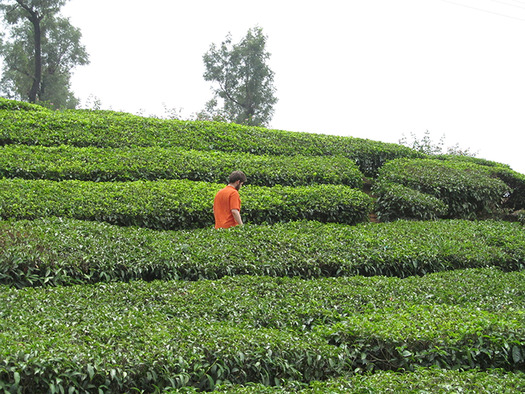
Inside a tea plantation (Figure 12)
March 31
Kumarakom
Kerala
From nearby Kumarakom we ventured onto Kerala’s famous backwaters on a classic Indian houseboat. These fresh water canals, centering on Vembanad Lake, lace the coast from Paravur to Alleppey, a distance of some thirty miles. The walls of these canals are actually government maintained dikes that serve as both home and highway to the people who live atop them. Behind them are the fields, flooded at monsoon time by these very same waters. Houseboats, kettuvallam or rice-barge style vessels, once made entirely of wood, now have steel hulls, with a wooden deck and superstructure. Most are outfitted with a galley, air conditioned bedroom, and roofed elevated viewing deck, and the better ones are environmentally certified for recycling wastewater. An overnight 60 kilometer round trip costs about $100 including three delicious home-cooked Keralan meals. Houseboat exteriors are finished with an elaborate covering of woven mats anchored in place with bamboo strips and braided coir (Figs. 13-14). The windows are surrounded by small, rope-framed gables that protrude slightly, creating a rain baffle. Since we have come in the off-season, the canals are beautifully peaceful, but in high season, December-January, as many as 1000 houseboats ply these waters, with congestion and environmental damage the result.
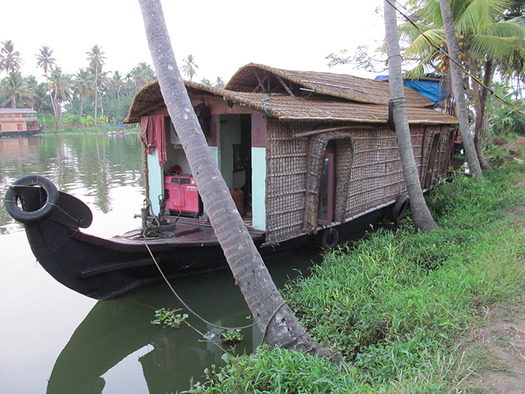
Night moorage of kettuvallam houseboat (Figure 13)
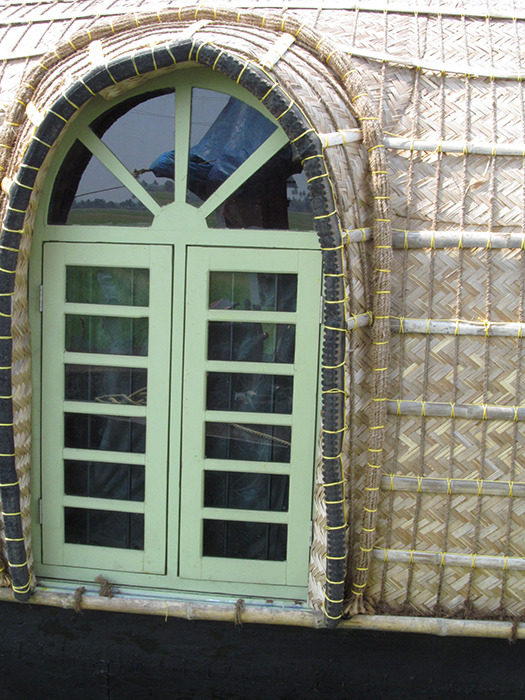
Detail of boat window (Figure 14)
April 1
Alleppey
Kerala
In Alleppey, a Keralan town on the Arabian Sea near India’s southwestern tip, fishing is one of the traditional professions, so rope made from coir , or coconut husk fiber, is prevalent. A brief stop at a coir mill in passing one day reveals about a dozen people working in a large open-air shed in various capacities. Some workers are weaving coir mats, some are coiling or spinning rope, others are shaving the completed mats for loading onto a waiting truck (Figs. 15-16). This is Arundhati Roy country, and the God of Small Things is in abundant evidence. We leave 200 rupees as a thank you so the workers could all enjoy midday tea.
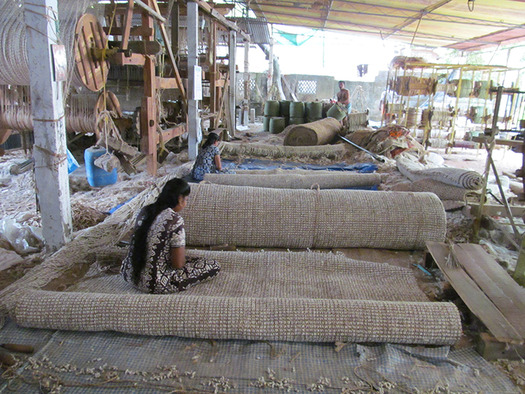
Coir mats being shaved (Figure 15)
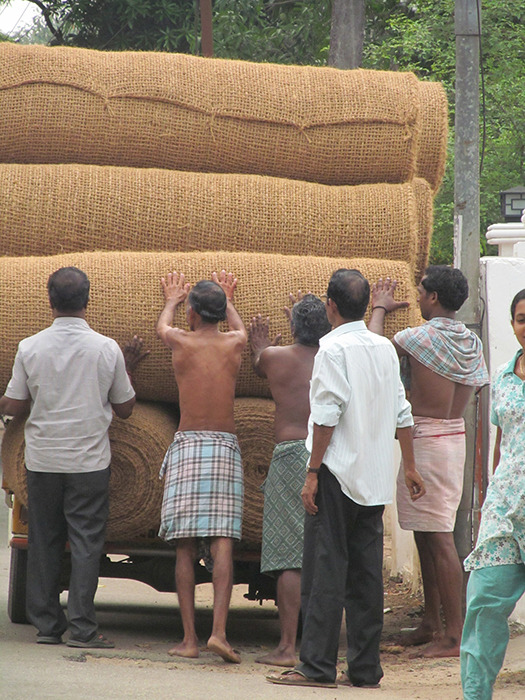
Coir mats being loaded for transport (Figure 16)
May 11
Pondicherry
Tamil-Nadu
Travel in India is varied, and challenging. When we journeyed to Kerala we took a train, the overnight air-conditioned Yesvantpur Express, to Cochin. On this visit to Pondicherry we’ve had to settle for an overnight AC Volvo bus. The train gets our vote for the smoother ride, and trains in India are heavily traveled, but the one to Pondy leaves only once per week, and returns the very next day.
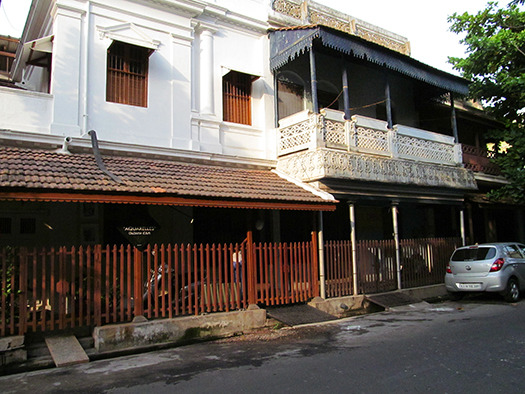
French quarter, Pondicherry (Figure 17)
Located on the Bay of Bengal, India’s eastern sea, Pondicherry is a charming vestige of a former French territory. It remained in French hands for a number of years after Indian independence in 1947, and still features a French consulate. The old town is composed of mansard-style building façades, and, as in New Orleans, houses feature balconies, jalousies, and interior courtyards (Figs. 17-18). French food is still available, too, and we availed ourselves of a wonderful dinner of steak au poivre avec pommes frites.
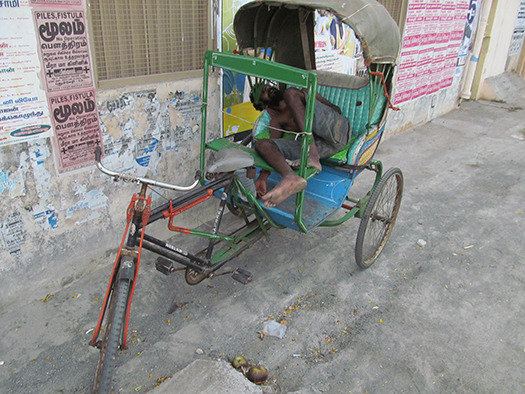
Sleeping bicycle rickshawman (Figure 18)
Outside Pondy is the UN Township of Auroville, the peace and sustainability community founded in 1968 by Sri Aurobindo’s followers. Although it is small and cultish, and has been surpassed by the awakening of the rest of the world to the need for sustainable design practices, Auroville once was a living pilot project, pioneering such sustainable technologies as solar ovens, waterless toilets, and a variety of cottage industries. Practice has taught residents that it is easier to subcontract work to shops in Pondicherry and Chennai than it is to bus laborers to Auroville, but as a privileged community in an impoverished rural setting, such efforts still benefit the surrounding towns. Aurovillians hold regular events outside the Mantrimandir, Auroville’s iconic high 20th century gold-domed geodesic peace shrine (Fig. 19), while nearby the grounds are enclosed by a more traditional fence (Fig. 20). These days, 2100 people consider themselves members of the Auroville experiment, subject to special visa dispensations from the Government of India.
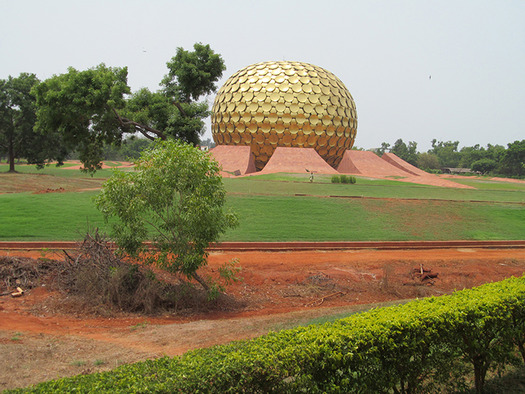
Auroville's peace shrine, the Mantrimandir (Figure 19)
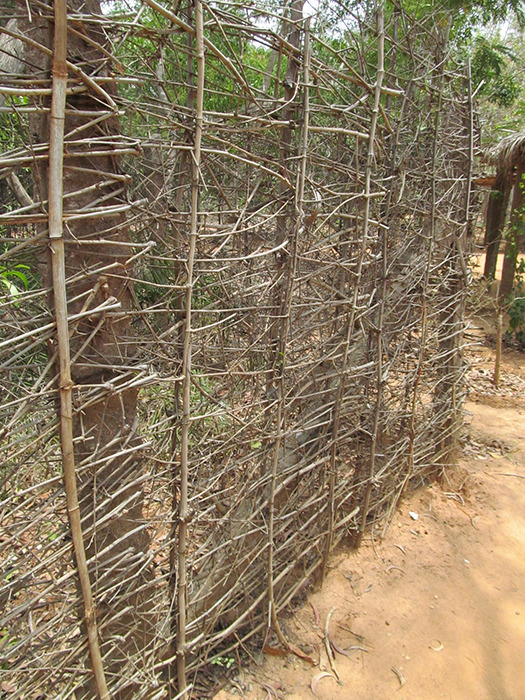
Nearby fence made of woven sticks (Figure 20)
May 31
Yelahanka
Bangalore
An acquaintance has referred me to a textile-printing studio, the last in town. Here fabric is laboriously pattern printed by hand (Fig. 21), just as William Morris once did at Morris & Co., with hand-carved teak wood blocks (Fig. 22). In an effort to avoid toxic exposure, workmen use gum Arabic-based paints for printing the custom-produced yardage.
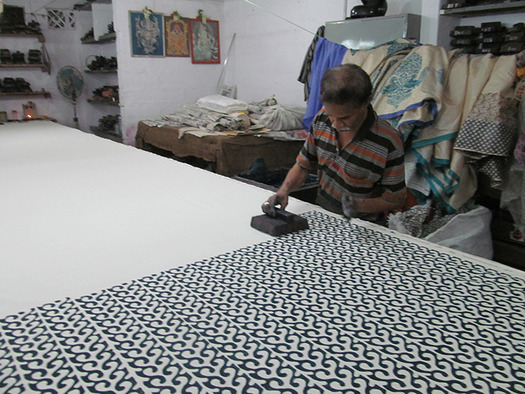
Hand-printed fabric (Figure 21)
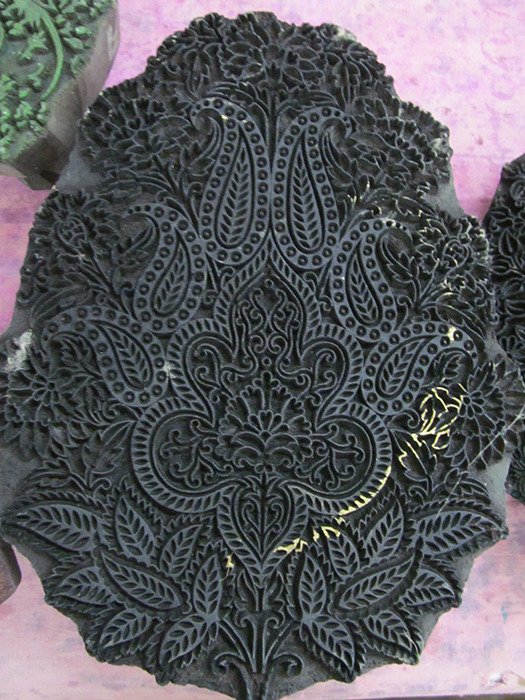
Hand-carved teak printing blocks (Figure 22)
The owner, Padmini, has referred me onward to the company that supplies her fabric. My son and I are met by a blue Suzuki at the foot of a giant Hanuman statue outside a temple in northern Bangalore. As we wind through the narrow streets, Chris comments how much the environment reminds him of Africa. In a dead-end alley our driver/host, Raghava, pulls a tight three-point turn and we pile out in front of a non-descript three-story building. As we pass through the doorway into a darkened hallway the deafening sound of power looms fills the air. About two-dozen looms are jammed into two dimly lit small rooms tended by two or three operators (Fig. 23). Not all the machines are working, but the din is still painful, and none of the workers is wearing ear protection. These pre-programmed machines, essentially utilizing late 18th century Jacquard punch-card technology, are pumping out saris in standard widths with metallic border-edge decorations. About 10% of the output here is slated for export to Singapore and Malaysia, other places where the sari is commonly worn.
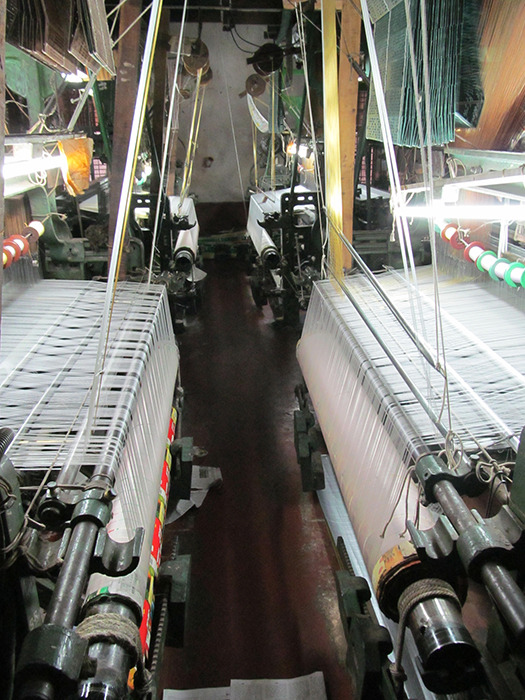
Power loom workshop (Figure 23)
In a few minutes we are back in the car and moving to another nearby workshop, also owned by Rajesh Doraswamy, Raghava’s uncle. Here, though, the environment is much improved. We’ve entered a shop where about a dozen of Bangalore’s 200 remaining commercial handlooms are located (Fig. 24). There is light in the big room, and children are present. Workers live upstairs from the loom room with their families, and it’s much quieter than the power loom rooms. It’s a Sunday morning, a big market and temple day, and only two or three weavers sit in their treadle pits weaving saris for specialized use at weddings and other ritual events. Although there is a demand for these products, Raghava estimates that all handlooms will be gone from Bangalore within five years, outperformed by mechanized weaving. One of the workers dons a scarf while proudly posing beside his work.

Hand-weaver in Bangalore (Figure 24)
June 12
Benares
Uttar Pradesh
In mid-June we travel by air north to the holy city of Varanasi, or Benares, and I get a little closer to my pre-conceived notions of India. It is here that the sacred Ganges makes a wide arc flowing north through town, and Guatama Siddhartha gave his first public sermon at a deer park in nearby Sarnath. To say that design in Benares is in service of the sacred is to understate the facts. Religious ritual is so much a part of the city’s identity it’s difficult to imagine what it would be like without it.
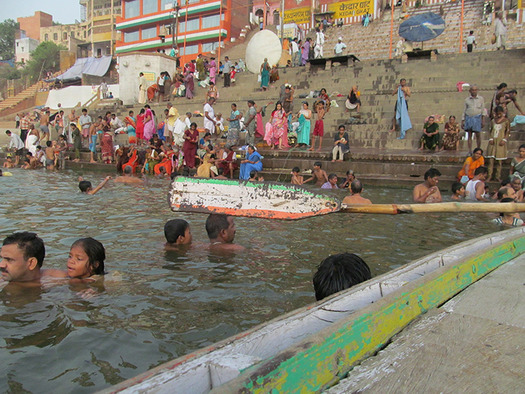
Kedawar Ghat, 7am (Figure 25)
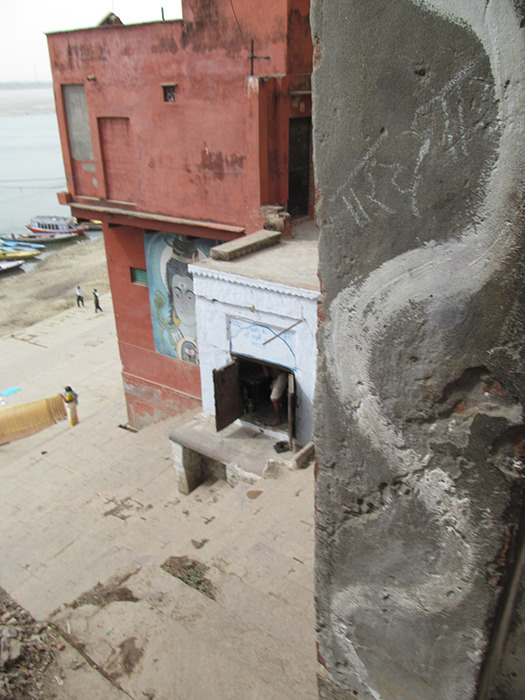
8'x8' apartment (Figure 26)
Benares is famous for its ghats , pyramidal steps leading down to the river in many places. On these stone stairways residents descend to bathe, wash clothes, work on or travel by boat, swim, and recreate (Fig. 25). Elderly Indians can be seen laboriously ascending these stairs to their small apartments after an early morning puja , or purification ritual (Fig. 26). Every day dozens of people are cremated at Manikarnika, the main “burning ghat,” while the sick and terminally ill stay in nearby hospices overlooking the crematoria, awaiting their deaths. At dawn, as we drift past the cremation ghats, my son dangling his feet in the water, a dead dog floats past, another reminder of life’s fleeting passage.
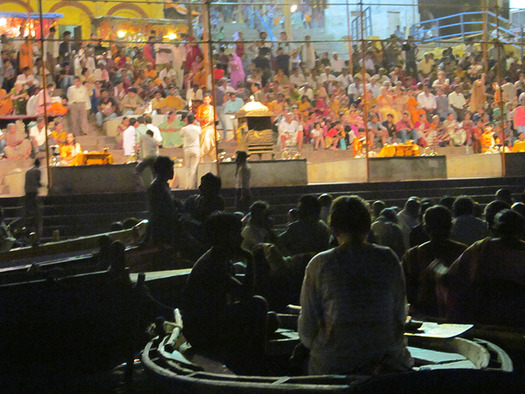
Dasaswamedh Ghat, evening ritual with floating audience (Figure 27)
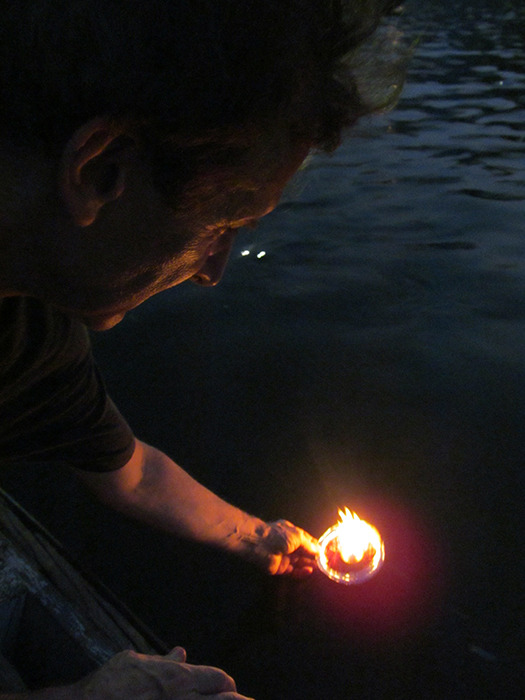
Lotus candle (Figure 28)
Each night Hindu priests conduct a public ganga aarti ceremony of prayer and song at Dasaswamedh Ghat (Fig. 27) while dozens of boats filled with tourists dock nearby. The river is sprinkled with lotus candles, available for 10-20 rupees, set afloat by pilgrims and tourists alike (Fig. 28). Some of the devotional devices are simple yet elegant.
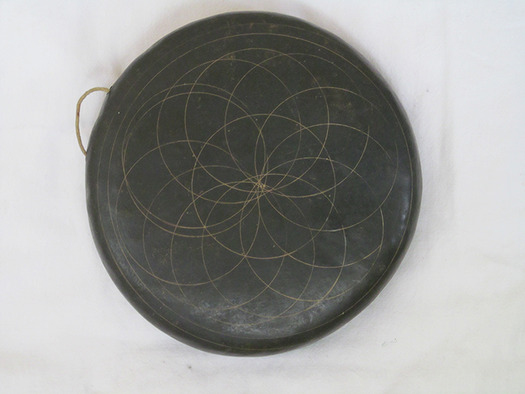
Gong (Figure 29)
A familiar sound along the river is of gongs and temple bells, which ring all day long. Some are plain but resonant brass discs, others are made of shaped hammered sheet metal (Fig. 29). A small Buddhist prayer wheel (Fig. 30), made of turquoise and coral, expedites the devotional process.
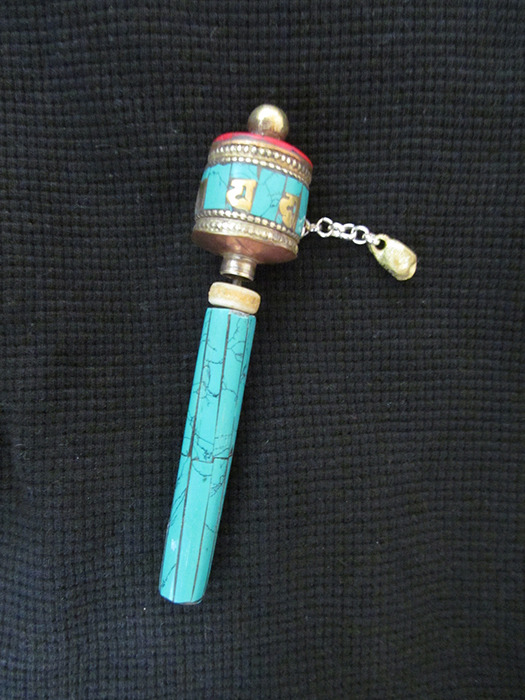
Prayer wheel (Figure 30.)
Images of deities and devas are available from kiosks that line the mews and alleys running along the river above the ghats. Superstars, like Shiva and his son Ganesh the elephant god of good fortune, adorn large murals on the riverside (Fig. 32). Temples are everywhere nearby, and their superhuman devas assume supra-human size, like this large statue of Hanuman the monkey god (Fig. 31).

Hanuman statue atop temple (Figure 31)
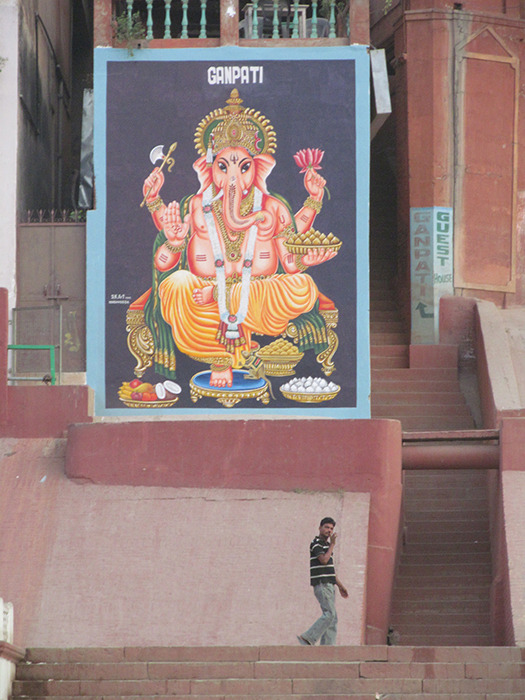
Ganesh mural (Figure 32)
In Benares, the guest-house we stay at has AC for its badly insulated drafty rooms, but it is still useful in the 115°f/95% humidity weather the city is experiencing. Few of the natives use AC. They prefer elegant small hand-held fans made from plant leaves (Fig. 33), and the passive ventilation of evening breezes off the river to cool themselves down. And many sleep outside at night, on the porch, on the roof, or on a boat, sustainability with a little sweat. In the alleys nearby I find a pair of Ayurvedic sandals (Fig. 34) that I liken to meat tenderizers that supposedly massage all ones' internal organs simultaneously, the hands and feet considered mirrors of internal reflex.

Benares fan (Figure 33)
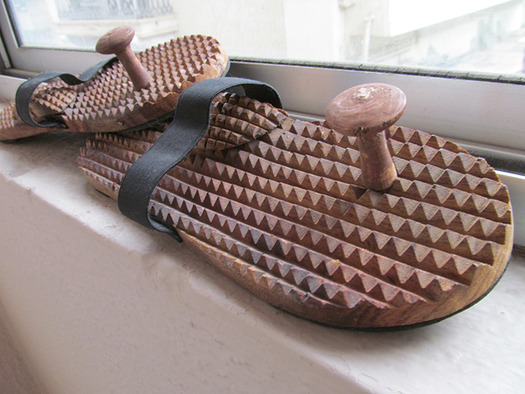
Ayurvedic massaging sandals (Figure 34)
June 14
Khajuraho
Madyha Pradesh
From Benares we drive for nine hours the 300 miles across Uttar and Madhya Pradesh to the dusty little town of Khajuraho. This is dry country in June before the monsoons. For one hundred miles of rough two-lane blacktop all one sees are building-side ads for Jaypee Cement, a major local industry. Khajuraho is like a place time forgot. Once a thriving complex of over 80 temples, between 950 and 1150CE the greatest erotic sculptures in human history were carved here by thousands of craftsmen of the Chandel Rajput dynasty and added to the facades of these temples. Ironically, although this is cement country, the structures themselves used none; they stay held together by clever joinery and the sheer weight of tens of thousands of stones (Fig. 35). It is estimated that only ten percent of the sculptures display erotic themes, the majority being of gods, animal deities, and everyday activities, like bathing (Fig. 36) and making up, as well as simple design motifs. But the overall sensual character of most of the carvings makes them very distinctive. And the superstructures themselves, enclosing small interior shrines, vault skyward in a manner that is archetypically Indian.
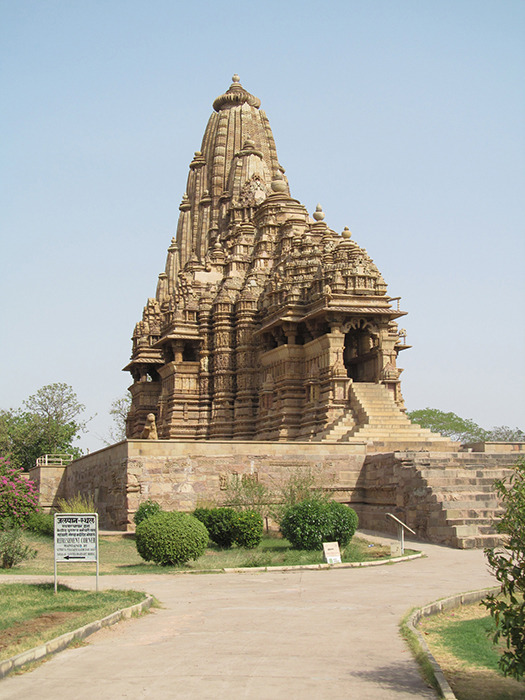
Kandariya-Mahadev temple (Figure 35)
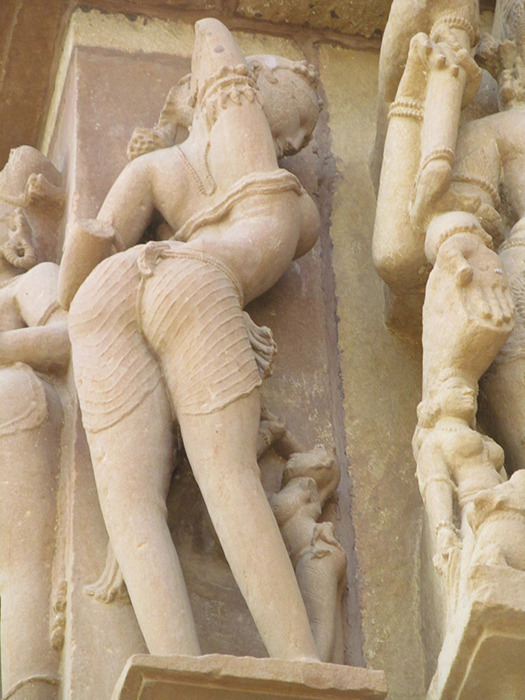
Woman in wet sari bathing (Figure 36)
June 16
Kolkata
West Bengal
Kolkata, is the great Bengali city developed by the British East India Company from its 1690 charter granted by the Nawab of Bengal, a minor Mughal potentate. The cultural and economic center of the country in the late 19th century as the capital of British India, Calcutta today is a burgeoning city of 14 million. Squatter tents sprout on narrow strips of land beside highways while new apartment construction stretches as far as the eye can see near the airport.
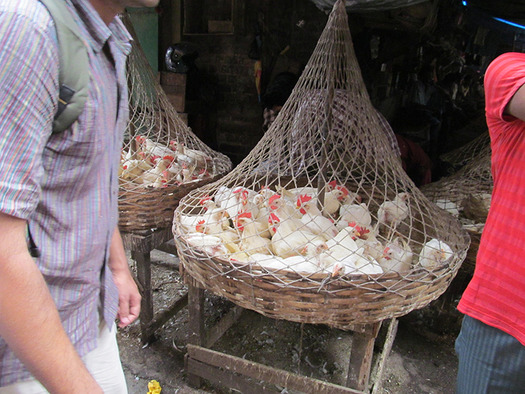
Chickens at the Hogg Market (Figure 37)

Goats in transit (Figure 38)
At the Hogg Market near New Market (Figs. 37-38) in the Chowringhee neighborhood, we visit the central meat and fish market, with its hanging sides of pork and goat meat, net baskets of live chickens, and huge slabs of ice used to keep fish fresh. At an antique dealer’s shop on nearby Park Street, location of a famous British cemetery dating back three centuries, we find a wonderful sign for a ladies restroom with designations in Hindi, English, Urdu, and Bengali (Fig. 39). The woman is pictured holding her lota with the proper hand for pouring, her right, or eating hand.
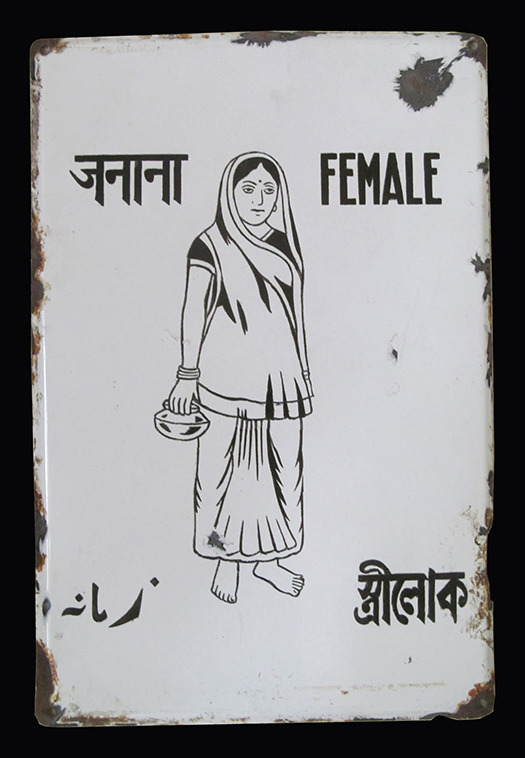
Ladies Restroom Sign (Figure 39)
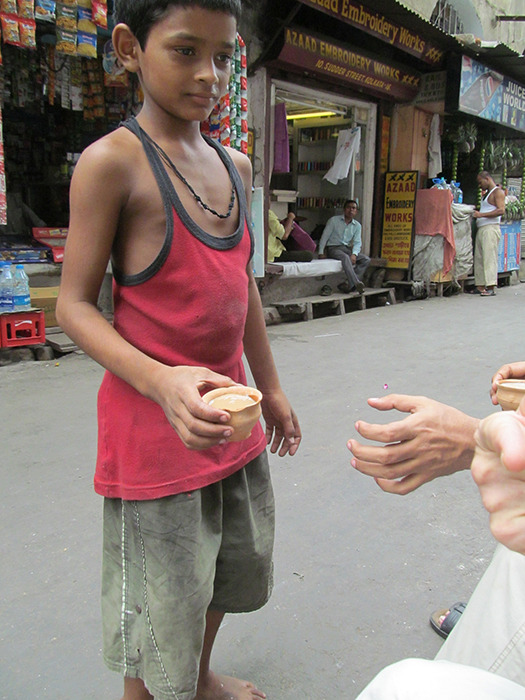
Tea Wallah (Figure 40)
We stop to have tea at a street side vendor’s stall, and are served by a delightful boy who dances as he serves us (Fig. 40). In other parts of the country one’s cup of super-sweet afternoon milk tea might be served in either a paper or a glass cup. In Calcutta it is served in a small terra cotta cup that one crushes on the ground when finished. The traffic in Calcutta is, if anything, worse than elsewhere. There are fewer manual and no bicycle rickshaws, the mainstay of Benares, but the streets are clogged by the famous Calcutta Ambassador yellow taxis, originally based upon the Morris Oxford, and manufactured by Hindustan Motors since 1958. Many vehicles cover their blinkers with wire guards to prevent breakage in the unforgiving traffic (Figs. 41-42).

Jain blinker light guard (Figure 41)
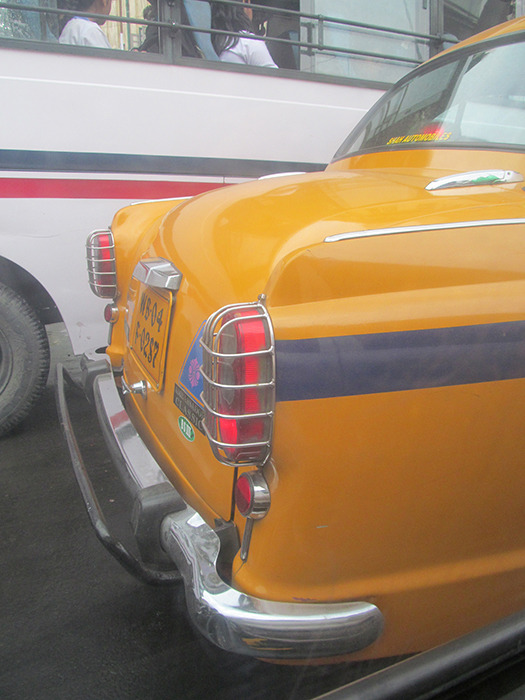
Ambassador taxi (Figure 42)
India’s modern design culture, dating back to the formation of the National Institute of Design following the Eames’ India Report in 1958, is noteworthy. Indian students of design are more aware of social problems than their American counterparts, and competition for acceptance into the better design schools is keen. But, aside from the two-century aberration of British colonialism, India’s overall design history is distinguished by its syncretic qualities. Decorative design is so much a part of everyday life that women use rice flour to create lotus-shaped rangoli patterns (Fig. 43) outside their homes each morning while truck drivers decorate their mudflaps with similar motifs (Fig. 44). While India’s first Prime Minister, Jarawlahal Nehru, favored the hiring of 20th century design luminaries, like the Eames’, or Corbusier, the architect of Chandrigar, India’s temples and World Heritage sites, like Khajuraho and the Taj Mahal, are evidence of the nation’s ability to absorb and adapt outside styles and concepts. This adaptability, the thing that has allowed India to survive so many invasions while still exporting its philosophy to the world, is a source of great strength.
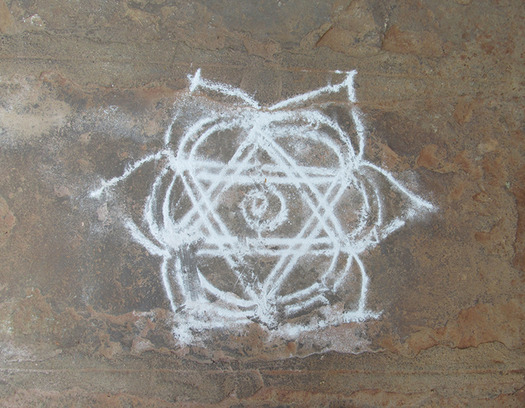
Lotus rangoli (Figure 43)
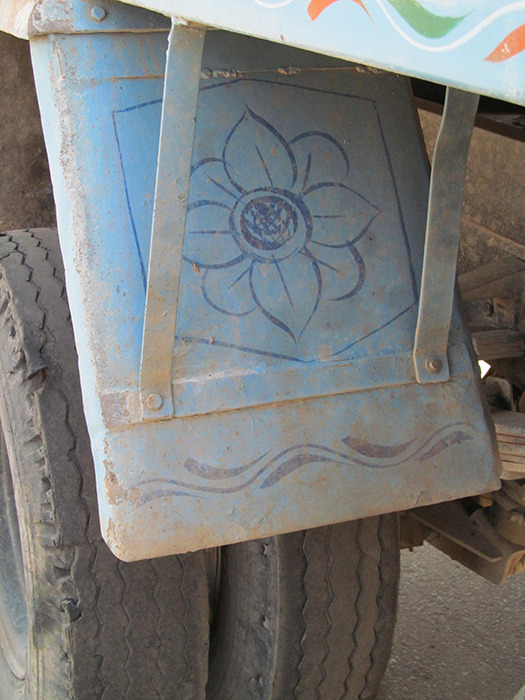
Lotus mudflap (Figure 44)
June 28
Jaymahalal Palace
Bangalore
Back in Bangalore, I am having a final drink with a designer friend. My friend is an alumnus of the National Institute of Design, but he thinks NID has seen better days. Government subsidies, followed by corporate co-optation have damaged NID’s relevance at just the time when India is in need of expert guidance. This cannot take the form of outside intervention; Indians are justifiably proud of both their design abilities and heritage. But internal corruption is the concomitant of the country’s 6+% growth rate (Fig. 45). India’s environmental laws are as tough as anywhere, but their implementation is lax, with government officials easily bribed. Land use laws enable developers to grab tracts condemned by the government, while multinational mining conglomerates lay waste to remote rural areas. India, with a fast-growing number of millionaires, also has 600,000,000 poor people, the largest percentage of disenfranchised per population of any nation (Fig. 46). Suicide among farmers has become a national epidemic. My friend is working with a community in Jaipur that is trying to protect its land. Unfortunately, the local talent he hired to develop an educational film did not do the work assigned, and he had to import outside experts to complete the project.
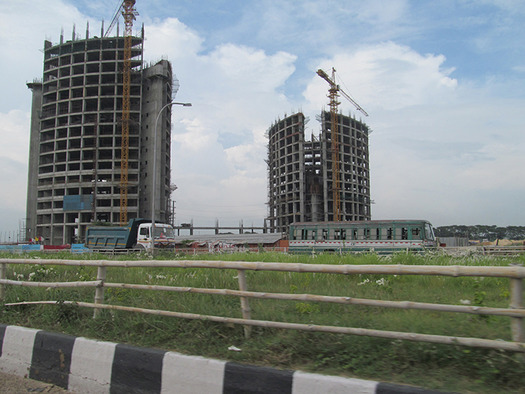
High-rise construction near Calcutta airport (Figure 45)
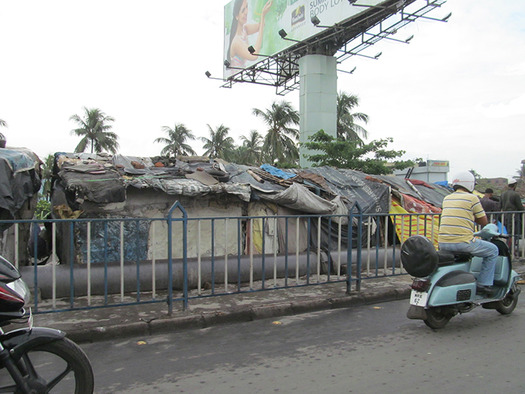
Roadside squatters (Figure 46)
In Bangalore, growth continues at a frenetic pace. The city is situated mid-way between northern India, and the Indian communities in Burma and Malaysia, and is dedicated to taking full advantage of its location. Blessed with the elevation that brings a mostly cool climate, free from malaria, Bangalore has for generations been a destination for pensioners and retirees. With the dramatic growth of India’s IT sector, a newer, younger demographic has descended on the city. Rapid urban growth afflicts it as much as any place but, like most Indian cities, Bangalore has been working on a comprehensive urban plan since the 1960s. Water use, wetland preservation, economic development, housing and the homeless, road and communication infrastructure, litter and trash removal, these are just a few of the things the Bangalore Development Authority must consider. Its latest master plan (2015) includes the first GIS survey of Bangalore’s water resources (Fig. 47). With efforts to protect the green areas surrounding reservoirs and catchments, and an aggressive rainwater-harvesting plan modeled on the City of Chennai’s program, Bangalore may be able to forestall the water disaster facing many urban areas of the developing world. As shopping malls continue to be built, and flyovers add a second tier of transport to an already crowded ground level, Bangalore, like its Indian sister cities, must decide whether, and how best to control population growth and urban sprawl.
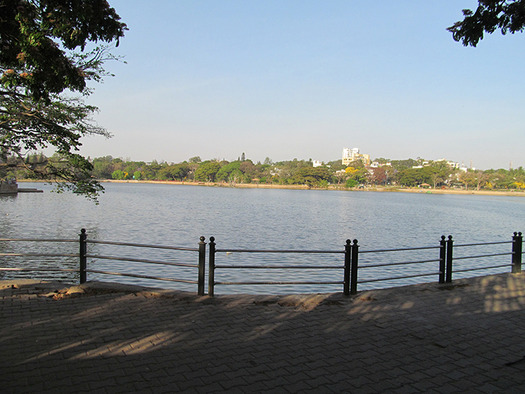
Sankey's Tank reservoir (Figure 47)
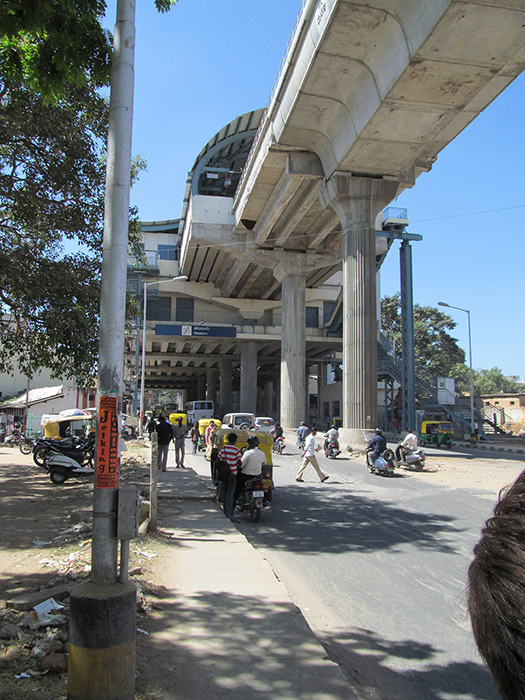
Bangalore's Namma Metro (Figure 48)
Symbols of progress, like Bangalore’s new Namma Metro (Fig. 48), an elevated railway snaking through town, are expensive to build and still lightly used. But street-level traffic is reaching a crisis as a newly enfranchised middle class flexes its purchasing power in response to advertisements for Mahindra SUVs and four-day vacation junkets to Goa. Design, as always, has an important role to play in this ongoing drama, and, in keeping with India’s history of absorbing outside ideas, that design will be a distinctive mixture of domestic and foreign, helpful and harmful. Pride also has a role to play. Although influenced by Britain (India has its own Penguin imprint that still uses Jan Tschichold’s 1940s cover redesign schema (Fig. 49)), India will determine its own future. After three hundred years of colonial abuse, technological eclipse, and crippling problems like famine and overpopulation India, fascinating, frustrating, diverse and ever changing, is fast emerging from its long slide into irrelevance as a 21st century superpower anxious to reclaim its former glory and assume its place among the first nations of the world (Fig. 50). It will do this in its own inimitable way, with a nod to the profanely modern, but with an ever-firm eye fixed upon the universal sacred.
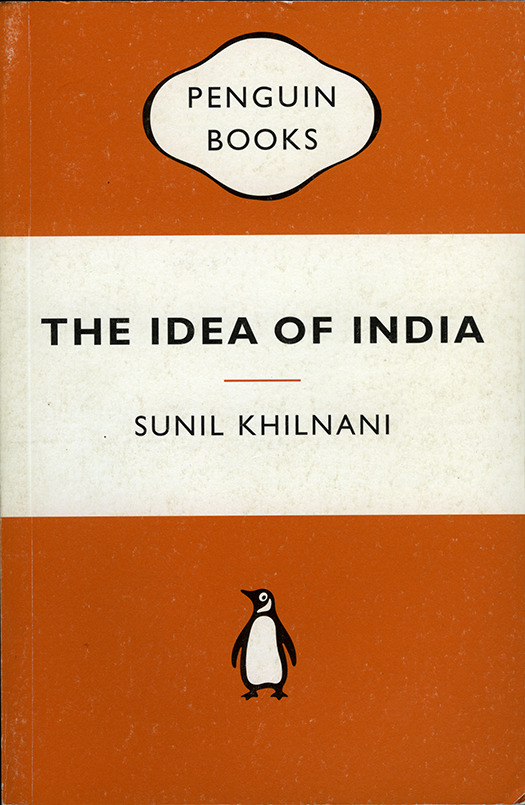
Indian Penguin imprint (Figure 49)
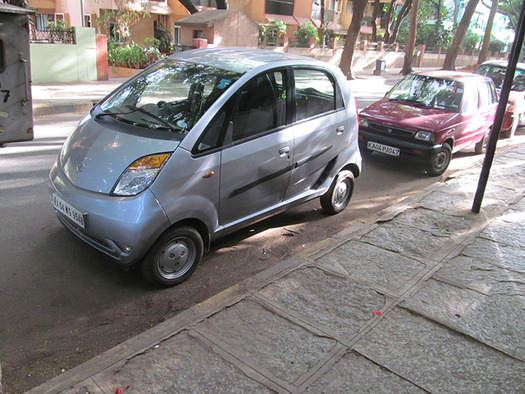
Tata Nano (costs about as much as a high-end laptop) (Figure 50)

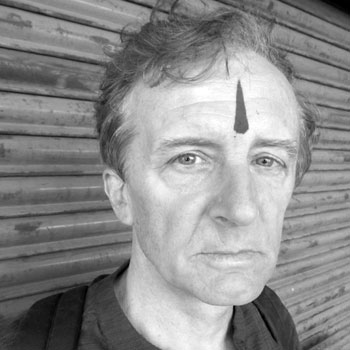
Comments [2]
I also wanted to point out a small typo, the city Corbusier designed is called "Chandigarh" and not "Chandrigar" as stated in the post.
01.16.13
06:36
It's my bad spelling, not a typo ;-)
01.16.13
11:34